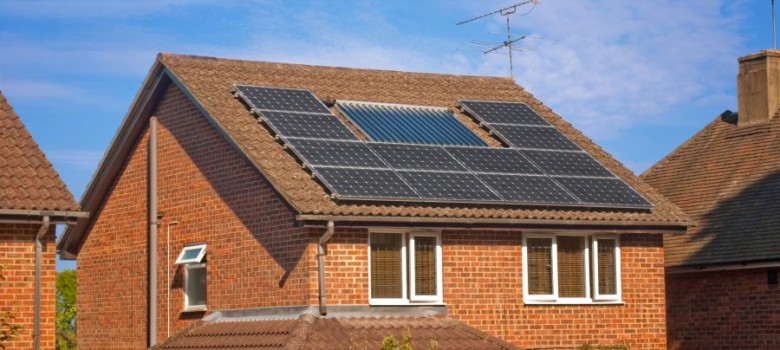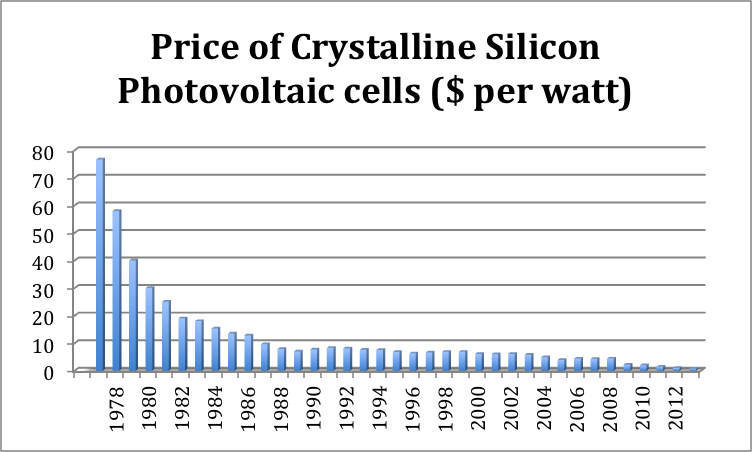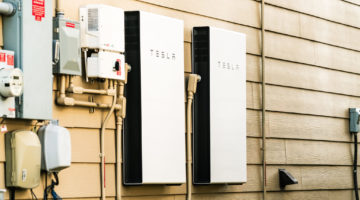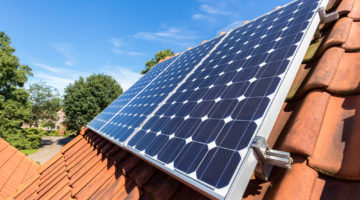
Solar Prices are Getting Cheaper
In a world that seems to be getting more expensive on a daily basis it is refreshing to read that one of the great hopes for our future energy security is significantly reducing in price across the globe.
The following graph shows the price of crystalline silicon photovoltaic cells when they came onto the market in 1977 and how the price has decreased over ever since.
The rule of thumb for this decrease is that the cost to generate the photovoltaic cells falls by 20% with each doubling of global manufacturing capability.
Solar – A maturing market
The solar industry is a funny one, since only a few years ago installing solar panels on your roof was seen as somewhat of a luxury because they were prohibitively expensive and the financial payback was 15 – 20 years or more.
Then all of a sudden, the Chinese Government invested heavily in solar via the Chinese Development Bank, which provided very cheap debt to solar manufacturers as well as tax breaks and subsidies. In 2010 alone, $30bn was handed out to 5 solar companies in China, allowing them to expand their operations very rapidly, leading to a much higher manufacturing capacity.
This move by the Chinese effectively turned the whole industry on its head, but quickly resulted in supply vastly outstripping demand, resulting in solar cell prices tanking.
Now obviously this isn’t good news for the big solar manufacturing companies outside of China who are looking to make profits from the goods they are selling. Only a few weeks ago, Suntech, one of the world’s biggest solar panel manufacturers, defaulted on a $500m bond payment.
In fact, in an effort to slow the massive influx of Chinese manufactured solar panels, the EU has imposed anti-dumping duties on Chinese solar imports having found that they were selling them in Europe at 88% lower than cost. This tax import rate is currently set by the EU at 11.8%, however if China refuse to stop their solar panel dumping the rate will go up to 47.6% in August.
This unfortunately has created an issue for many UK based installers who get their panels directly from China, since they will no longer be able to import them so cheaply; a situation that could mark the end of the cheap home solar PV installation
The Tanking solar Price is (currently) great for Consumers
Thus far, this fierce competition introduced by the influx of new Chinese solar companies has been great for consumers (driving down prices of solar panels), but if UK installers need to start paying almost 50% tax on the panels they import then their prices will need to increase accordingly.
It is currently possible to buy a 4kW system in the UK for approximately £7,000 – £8,000. A system this size should produce about 3,400kWh of electricity per year. If you were to use half of this yourself and sell half back to the grid you would make approximately £850 per year as per the calculations below.
| Payment (£) | kWh | Cash to you | …………………………………………………… |
| 0.154 | 3400 | 524.96 | Generating Tariff (part of FiT) |
| 0.045 | 1700 | 76.50 | Export Tariff (assumed 50%) |
| 0.140 | 1700 | 238.00 | Saving on electricity bill |
| ………………… | Total | 839.46 |
Therefore the payback is less than 9 years, and then you will continue receiving the subsidies for the next 10/11 years (20 years after installation).
This is obviously the situation as it is today, but this could change in a matter of weeks – so act quickly to ensure you get the best deal on your solar panels. The Feed in tariff is also reviewed on a quarterly basis, so is likely to continue to fall over the coming years, so now is the perfect time to install a solar system.
Looking Forward to the Future
Despite the issues surrounding the cost of the panels resulting from the sudden increase in Chinese manufacturing capacity and the EUs decision to tax panels made there, the technology that goes into making the panels is improving on a seemingly daily basis.
Even last week, the Stanford Institute for Materials and Energy Sciences announced massive efficiency improvements (about a 100 fold increase) on a solar cell that can convert all solar wavelengths into electricity (current PV only uses the visible spectrum). Where heat negatively impacts traditional solar PV cells, this new technology performs substantially better in warm conditions.
I have written before that it will be a big day for solar when installed it can produce electricity at the same price as traditional fossil fuels (which is almost the case in California now) – known as grid parity. And hopefully one doesn’t have to look too far into the future to a time when grid parity could be reached in sunny UK too, there just might be a few speedbumps along the way!












You havent mentioned the cost of replacing the inverter,I was advised by the company that installed the Yingli panels and aurora inverter at my house that inverters last approximately ten years. At that time,2010 inverters were in short supply and cost £2000. Are inverters now still as costly and are they more efficient? Thanks
Hi Tony, Inverters are much more cost effective now to be honest. In many cases we suggest installing microinverters now too – so each panel has its own inverter. These although marginally more expensive to install will last longer (some come with 20 year warranties), but also they maximise the amount of energy harvested from the solar PV setup since a solar PV array will always operate at the efficiency of the worst performing panel when there is just one large inverter. Microinverters allow each panel to operate individually at their own efficiency!
Thanks for the comment though Tony – much appreciated – a really good point raised!
Hello James. I had 3.84kw worth of panels fitted four years ago. I was told that domestic wiring couldn’t handle more than 4kw. I have seen comments referring to 5kw installations. Can domestic wiring handle that? If so, would it be possible to fit another 1kw to my existing set up? Would that require a new inverter or would it be possible to connect microinverter panels?
Hi Gerald,
That is a question you are going to have to ask your solar PV installer!